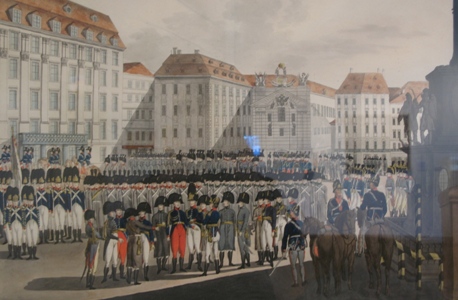ART AROUND 1700
Baroque Vienna
In the decades following the Turkish Wars (1690-1730), Vienna grew into an international center of the arts. During this period of intensive reconstruction, the court, the aristocracy and the church commissioned monumental buildings that still define the face of the city today, such as Schönbrunn Palace, the Church of St. Charles (Karlskirche) and the Upper and Lower Belvedere. Combining architecture, sculpture and painting, such baroque “Gesamtkunstwerke”, or total works of art, were meant to reflect both social position and the intentions of their builders. The most important architects of this period were Johann Bernhard Fischer von Erlach and Johann Lukas von Hildbrandt.
Artists such as Johann Michael Rottmayr and Daniel Gran produced monumental frescos and paintings with religious or mythological themes. At the court of Franz I and Maria Theresia, an artist of Swedish origins, Martin van Meytens, exercised the all-important role of imperial portrait painter. From all over Europe, artists and design experts flocked to Vienna.
Of particular culture and political significance was the founding of the Academy of Fine Arts under Karl VI. Althought at first administered privately, the Academy was recoganised ad a state-run public institute in 1726 on the initiative of its master, Jacob van Schuppen. Women were not allowed to study or train there.
VIENNA IN THE 18TH CENTURY
Captital of a Great European Power
In the 18th century, Vienna grew into the dazzling capital of a great European power. Majestic palaces and churches sprang up both within and beyond the city walls. Alongside the older settlements in the suburbs, members of the nobility built summer residences with large parks, such as the magnificien Belvedere Palace.
In 1704, the military administration constructed an outer defensive embankment known as the “Linienwall”, which followed the same route as today’s Gürtel road. Between the Linienwall and the zone surrounding the fortifications of the old city, there developed an area of nearly continuous settlement comprising some thirty suburbs.
Not until 1850 would the latter join with the inner city to form a single administrative unit. During the 18th century, the transformation of Vienna from a court-based feudal society to a bourgeois society can be observed in a number of measures: the reorganization of the guilds, the abolition of torture and the death penalty, the introduction of primary education, the increased tolerance toward Jews and non-Catholic Christians, the founding of social institutions such as the General Hospital and the opening of the Prater recreation area to the general public. The appearance of the city changed during this period with the construction of new public buildings, the dissolution of many monasteries and the relocation of graveyards beyond the city walls. In addition, the population increased by a factor of four: in the last quarter of the 18th century, the number of people living in Vienna and surrounding suburbs exceeded 200,000 for the first time.
VIENNA AROUND 1800
From the French Wars to the Congress of Vienna

Parade of the guards of the Viennese civil military corps at the civil arsenal (Zeughaus) on the square "Am Hof", 1805
Paul Weindl after Franz Hegl
The wars between Napoleonic France and the older monarchies transformed the face of Europe. Among other things, they brought about the disintegration of the Holy Roman Empire. In 1806, Franz II declared the latter dissolved, since 1804, he held the title “Emperor of Austria”. As a result, Vienna gained the status of imperial city of Austria, but it lost its importance as a center of German politics.
In 1805, the French army occupied Vienna for two months, while Napoleon resided in the Schönbrunn Palace . In 1809, the Viennese attempted to repel another French assault, but after only a few hours, the city stood in flames and they were forced to surrender. It was on the battlefield between Aspern and Essling, today in the northeast of Vienna, that Napoleon suffered his first defeat. However, the French army soon reclaimed its military superiority at the Battle of Wagram. Before their withdrawal, Napoleon’s troops destroyed large sections of the city’s fortifications. In place of the demolished bastions that had stood before the Imperial Palace, builders then erected the “Neues Burgtor” (Imperial Gate), the Äußere Burgplatz (now Heldenplatz) and the “Burggarten” (Imperial Gardens).

The Congress of Vienna 1814/15
After Napoleon’s defeat, the rulers of Europe gathered at the ”Congress of Vienna” (1814-15) to establish a new political order in Europe. Vienna became the center of the Europe Restoration, which found its spokesman in the Austrian chancellor Metternich.
